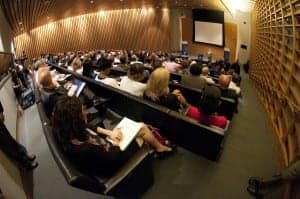Because I am a woman, I must make unusual efforts to succeed. If I fail, no one will say ‘She doesn’t have what it takes.’ They will say, ‘Women don’t have what it takes’ – Clare Booth Luce

Author and former US Ambassador Clare Booth Luce clearly articulated in the early 1900s the challenges that women in the 2000s continue to face in their professional careers. I was reminded of this quote as I listened to the impressive and inspiring speakers during the 19th Annual Wharton Leadership Conference on June 17, 2015. Heads of military, academics, journalists, coaches, public school leaders and art historians, all brought their own take on the theme, Preparing for Growth and Innovation in a Changing World. Throughout the day, I found myself coming back to the fact that all of their disparate experiences also speak so clearly to our work developing strong, gender-diverse leadership in financial institutions globally that serve low-income women.
Overcoming first impressions
The quote illustrates the difference between observation and inference or what we see and the meaning that we make. As is often the case for minority individuals in organizations, there exists a tendency to extrapolate one person’s experience or behavior to represent the experience or behavior of the entire group he or she represents.  In her session, The Art of Perception, Amy Herman talked about how she uses art to help professionals in a wide variety of occupations—from counter-terrorism, medicine, finance to industry—to develop better observation and communication skills. I have seen, in the organizations we work with, how observation can easily lead to inference and then to “reality.” For example, a staff member of a financial institution with no female branch managers once told us “I think this will not happen…we have never seen women working as managers here.” The way this individual saw, and then interpreted the organization, was also colored by deeply held beliefs about the roles that men and women play. When institutions experience the repercussions of unconscious bias we recommend implementing training for all staff to build awareness; establish clarity on evolving expectations, requirements and accountabilities; and reinforce desired behaviors. Training also serves as a communication channel to reinforce organizational diversity goals and can be used to dispel gender biases in recruitment and talent management processes.
In her session, The Art of Perception, Amy Herman talked about how she uses art to help professionals in a wide variety of occupations—from counter-terrorism, medicine, finance to industry—to develop better observation and communication skills. I have seen, in the organizations we work with, how observation can easily lead to inference and then to “reality.” For example, a staff member of a financial institution with no female branch managers once told us “I think this will not happen…we have never seen women working as managers here.” The way this individual saw, and then interpreted the organization, was also colored by deeply held beliefs about the roles that men and women play. When institutions experience the repercussions of unconscious bias we recommend implementing training for all staff to build awareness; establish clarity on evolving expectations, requirements and accountabilities; and reinforce desired behaviors. Training also serves as a communication channel to reinforce organizational diversity goals and can be used to dispel gender biases in recruitment and talent management processes.
What statistics can hide (or reveal)
Luce’ quote alluded to the way that one or just a few data points can lead to generalizations when that data seems to confirm an existing belief about the world. Kim Marshall, a teacher, administrator, and principal in Boston’s public school system for 32 years, showed a graph plotting school achievement versus poverty. He started by revealing just the “best fit” line, clearly showing a negative relationship—high poverty equals low performance. Next, he revealed all of the individual data points which revealed a number of outliers, including the abysmal performance of a school with zero poverty, and many schools with high poverty and good or event stellar performance. When he asked the audience to reflect on how this applies to our own work, I was reminded of the experience of going into a financial institution and being told that the reason that they cannot achieve gender balance on the staff is because women get married and leave. To test this assumption, we then asked for their attrition statistics and saw that, in reality, men were leaving at a rate almost twice as high as women. Like the graph on school achievement, having the attrition data showed us that yes, women are leaving, but so are men and having all of the data shows us that there is so much more to the story.
It turned out that the inference that women leave more than men was driven by a combination of deeply held beliefs and the impact of a few token women leaving the organization after marriage. Regardless of its origin, there was a real negative impact on the business and in its ability to fully access the talent pool it needed for success. If these managers could further hone their observation skills, ask questions like “do all women leave when they get married?” or “are there women who are suitable for the branch manager position?” and by looking at the full data set of the women who leave and those that don’t, a whole new picture will emerge.
Women professionals, going back to Luce and likely before, often express that they have to work harder than their male counterparts to achieve the same success and recognition. Another session in the Wharton conference was led by Professor Samir Nurmohamed who researches Underdogs and why we (sometimes) root for them. Again, I was reminded of one of the gender audits of a financial institution Women’s World Banking carried out where we seemed to see the underdog effect in action.
The institution, like many that we work with, operates in a cultural context where there are biases about men and women, and, in particular, the suitability of women for certain roles. Despite challenges women face in advancing professionally in this organization, some of the people we spoke to said things like, “if you give [a woman] responsibility, she wants to prove that she is better than men.” Applying Professor Nurmohamed’s model, there appears to be some combination of external disadvantage on the one hand, and passion and determination on the other, that is driving these particular women to not only succeed but to try and outdo their colleagues with whom the game is being played on a distinctively un-level playing field. Women’s World Banking’s recommendation for this organization included communicating a vision and business case for diversity to the staff, to dispel the deeply held beliefs and biases about women. This institution is lucky—it was in a position to harness women’s drive for success to spur positive competition among staff—and only needed to take advantage of and support this underdog effect so that it leads to real change.
Drawing these parallels from art, education and academia to the work that we do with financial institution leaders reminded me that new ideas and practices can come from even seemingly unlikely places. As I work with my team to develop the curriculum for our new Leadership and Diversity for Innovation Program, the 19th Annual Wharton Leadership Conference inspired me to look farther afield and find insight outside of the experiences from within our sector. In so doing, I hope that our work will continue to make a meaningful contribution to breaking down biases and providing new ideas and tools that will support our partner institutions in achieving greater gender diversity and, ultimately, better serving the women’s market.





